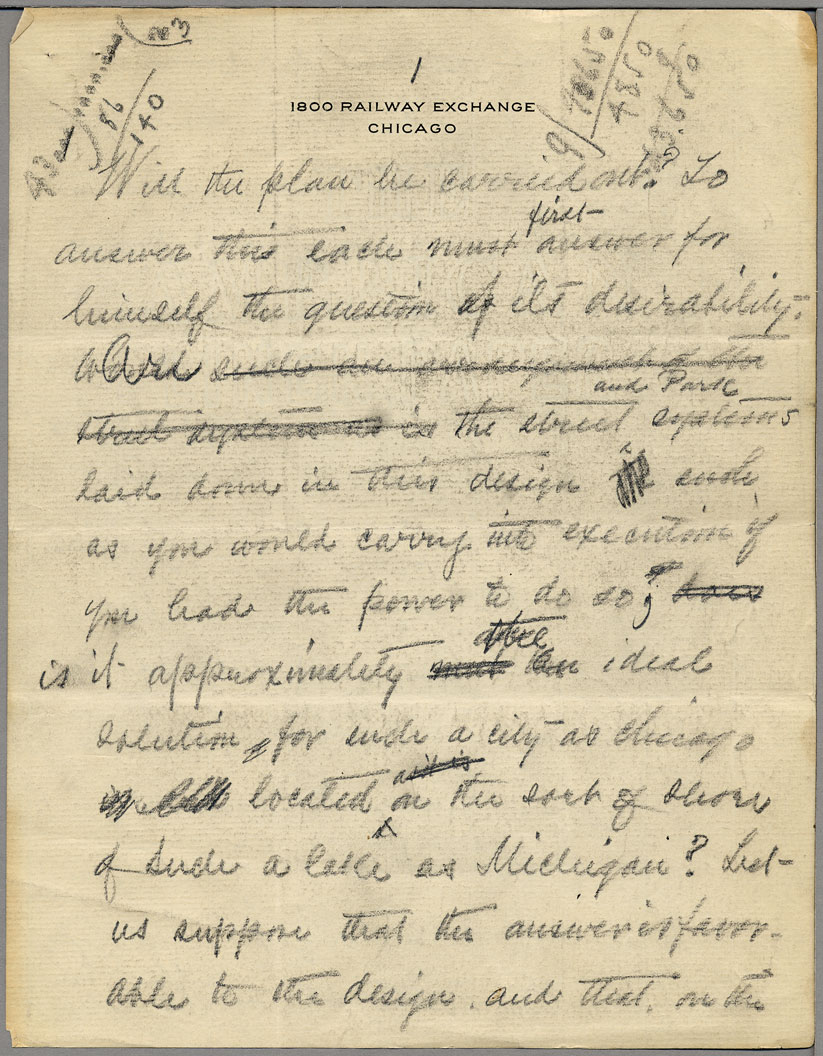Before the published Plan was distributed in 1909, Burnham presented the Plan of Chicago to a variety of
audiences. Accountable to the Commercial Club, he addressed
the planning committees, Club executive board, and general membership
on key occasions to report on his progress and rally support.
He also spoke of his plans to influential men in closed meetings, as
well as to the public at open events.
The speeches and drafts in this section show Burnham's main points in
marketing the Plan to various stakeholders. Burnham's goal
was twofold: to secure backing for the planning effort itself and to
create momentum for the eventual implementation of the Plan.
He was sure that arousing the imaginations of his audiences, as well
as convincing them that carrying out the Plan was only a matter of will
and commitment.
|
 |
TITLE:
DATE:
SUMMARY:
PDF:
|
Speech on beautification of Chicago, given to the Commercial Club of Chicago on January 30, 1904
01/30/1904
In this 1904 address to the Commercial Club, Burnham reiterates some of his ideas about the lakefront and suggests themes that will later underlie the Plan of Chicago. He mentions several areas in need of beautification, namely the air quality, streets and boulevards, the Chicago River, the lakefront, and public parks. An interesting aspect of this speech is Burnham's insistence that the influential members of the Commercial Club should hold city government responsible for civic improvements.
DOWNLOAD this document. (18 pages)
|
 |
TITLE:
DATE:
SUMMARY:
PDF:
|
Plan of Chicago meeting minutes: Annotated typescript of Daniel H. Burnham's speech at the 201st meeting of the Commercial Club of Chicago
01/25/1908
On January 25, 1908, Burnham and the other members of the planning committee—as well as representatives from each of the subcommittees—reported on their progress and recommendations. In his speech, Burnham reviewed the history of other city planning efforts including those in which he was involved, and then went over his plans for the streets, parks, and lakefront. Burnham apparently later returned to this transcript to make corrections in advance of an unidentified speaking engagement. See also the full report of this meeting.
DOWNLOAD this document. (38 pages)
|
 |
TITLE:
DATE:
SUMMARY:
PDF:
|
Speech on Plan of Chicago, unidentified portion showing placement of lantern slides of speech given at the Congress Banquet Hall on January 25, 1908
01/25/1908
Burnham prepared notes for his January 25 report to the Commercial Club but, according to a memo scrawled on the title page, did not ultimately follow them. Nevertheless, this portion of the notes shows how Burnham structured his speeches, particularly with the aid of lantern slides. As in the Plan itself, images shown during speeches helped illustrate proposed changes, as well as leant a distinct aesthetic character to presentations.
DOWNLOAD this document. (20 pages)
|
 |
TITLE:
DATE:
SUMMARY:
PDF:
|
Speech on Plan of Chicago, draft of speech for unknown audience
n.d.
Burnham realized he must convince stakeholders not only of the desirability of implementing the Plan, but also its practical viability. In this speech, he reiterates some of the arguments made in Chapter 8 regarding the cost effectiveness of the Plan. Burnham contended that although the recommended improvements would be expensive, the money was there—partly in the form of municipal bonds—if citizens demanded it. Ultimately, Burnham believed that the financial returns to the City of Chicago would far outweigh the cost of implementation.
DOWNLOAD this document. (12 pages)
|
 |
TITLE:
DATE:
SUMMARY:
PDF:
|
Speech on Plan of Chicago, "A plain talk on the plan for the future development of Chicago"
n.d.
This fascinating speech is remarkable for Burnham's unusually plain, straightforward language. Addressing Chicago's "common people," Burnham repeats his core arguments, but with an eye toward what he believes is most important to this demographic, for example cost of transportation, prevalence of public parks, and access to the lakefront. He insists, "the masses of the people will be benefited [by the Plan] far more than the rich," and closes with the proclamation that "more honorable men and women will result."
DOWNLOAD this document. (12 pages)
|
|





